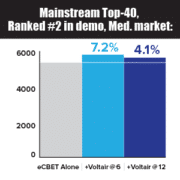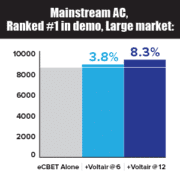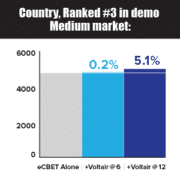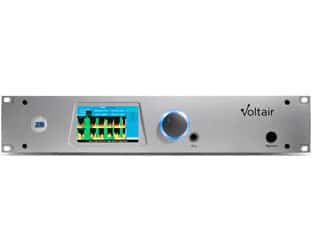 Voltair still works – even on enhanced Critical Band Encoding Technology (eCBET).
Voltair still works – even on enhanced Critical Band Encoding Technology (eCBET).
That’s the promotional message sent to radio engineering and industry professionals by The Telos Alliance on Tuesday, which says the Voltair Watermark Monitor and Processor’s abilities are proven “by dozens of stations who conducted toggle-testing and reported their results.”
At the same time, Nielsen is still not supporting Voltair but hasn’t stopped radio stations from using the PPM-boosting technology.
RBR + TVBR OBSERVATION (full text below, for subscribers): Geoff Steadman is a genius. Why? Because Voltair, as awful as it is, has been a money maker solely because Nielsen’s PPM technology is abysmal, outdated and ineffective.
In prepared comments, Geoff Steadman, founder of Voltair maker 25-Seven, said, “The watermarking monitor and processor continues to make a positive difference in registering meter count and overall watermarking performance, even in this post-eCBET world,” says Geoff Steadman, Founder of 25-Seven. “The data we’re getting both from the field and in our own labs speaks for itself, with the ratings advantage clear to see.”
How did the toggle-testing work?
A CHR/Pop station, AC station, and Country station in a large or medium market each ran a Voltair enhancement at 0, 6, and 12, changing every fifteen minutes for four weeks. They then analyzed the ratings at each enhancement level.
The illustration below shows ratings without Voltair in the left column, appearing in gray. The middle column, in light blue, shows ratings with Voltair set to 6. The right bar, in dark blue, shows ratings with Voltair set to 12.



The demo shows that CHR/Pop benefited with a setting at 6, while AC and Country each benefited from a setting of 12.
To help propagate the use of Voltair, the Telos Alliance is engaging in an effort “to help facilities get Voltair on every one of their signals” by offering promotional pricing of $9,950 on Voltair B-Stock gently used, factory refurbished units. New units are $15,000.
Most of these “B” units were purchased and returned immediately (if the wrong version was ordered, for example) or were used for the Telos Alliance’s ongoing testing programs.
Meanwhile, it’s been 13 months since the Voltair processor received a no-confidence vote from Nielsen Audio, which uses the PPM for its monthly radio audience exposure and listening estimates in large and medium-sized markets that have shed diary methodology.
According to Nielsen, Voltair’s audio processing system can, in extreme cases, affect the accuracy of one’s exposure to radio signals by the PPM.
This, along with the fact that Voltair is used by some but not all encoded radio stations, resulted in Nielsen declaring that it would not support Voltair.
Among Nielsen Audio’s other conclusions on Voltair:
* PPM can pick up more codes with Voltair “in some situations where background noise is equal to or greater than the audio content.”
* Voltair generates variability; when the “dial is turned up,” the effect on the watermark and the codes is increased.
* The Voltair effect was more visible at the minute-level than at the adjusted quarter-hour level
New watermark improvements were being tested at the time, and enhancements have recently been released by 25-Seven.
RBR + TVBR RELATED READS:
Controversial Voltair Processor Gets Update
RBR + TVBR OBSERVATION: Geoff Steadman is a genius. Why? Because Voltair, as awful as it is, has been a money maker solely because Nielsen’s PPM technology is abysmal, outdated and ineffective. We believe it is “awful” because we are audio geeks and are highly sensitive to any abnormal or irregular noise associated with our favorite FM stations. As recently as August 31, one station had its Voltair cranked up so high in mid-afternoon that a couple of songs sounded like they’d been recorded in a tin can. This was noticeable on the station’s audio stream; later in the day the audio returned to normal levels. We’ve noticed similar issues with other stations in the Rose City owned by Alpha Media and Entercom, while down in Miami the iHeart Radio FMs all have their Voltair so high it makes prolonged in-car listening a difficult experience. If this is what FM radio needs to do to get their radio signals detected by a PPM panelist, we believe it is time for Nielsen to retire the PPM and develop better technology. How about a smartphone app? What about a WiFi-enabled detector the size of a keychain that doesn’t require constant motion, so long periods of listening at the office desk will accurately be recorded? Voltair simply doesn’t seem to be the problem. Rather, it’s the tool that has pointed out the problem, and it’s spelled “PPM.”




